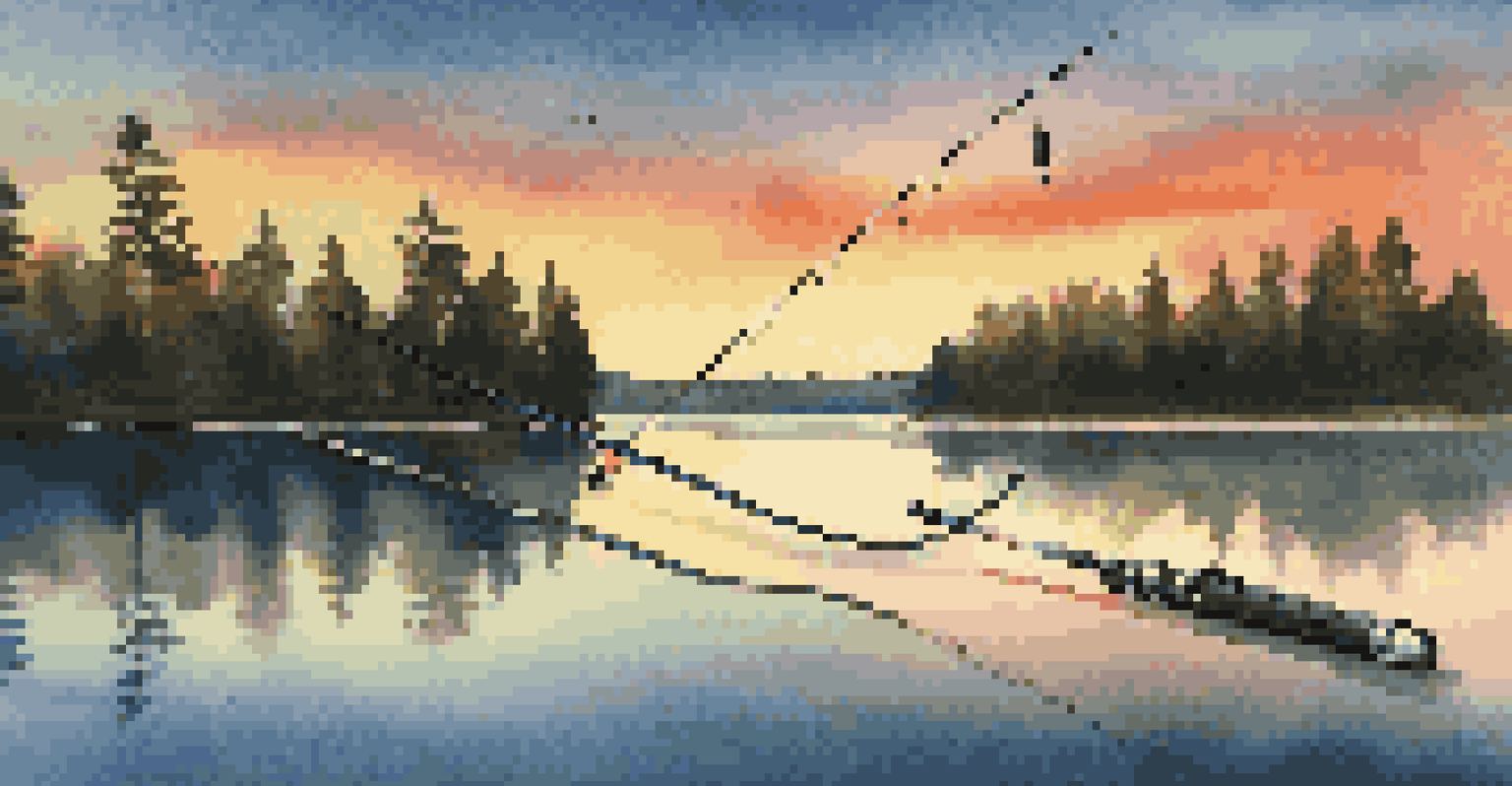The Role of Technology in Modern Fishing Techniques

Introduction to Modern Fishing Techniques and Technology
Fishing has come a long way from the simple nets and rods of the past. Today, technology plays a pivotal role in enhancing fishing techniques, making them more efficient and sustainable. From sonar devices to drones, modern fishermen are equipped with tools that drastically improve their catch rates and reduce environmental impact.
Technology is best when it brings people together.
The integration of technology into fishing practices not only helps in locating fish more effectively but also aids in understanding marine ecosystems. This shift has led to a better balance between commercial fishing needs and conservation efforts. As we delve deeper into this topic, we’ll explore the various technologies that are reshaping the fishing industry.
By embracing technological advancements, fishermen are not just improving their livelihoods but also contributing to responsible fishing practices. This evolution opens up discussions on how technology can help manage fish populations and protect aquatic environments.
Sonar Technology: Finding Fish with Precision
Sonar, or Sound Navigation and Ranging, has revolutionized how fishermen locate schools of fish. By sending sound waves underwater and analyzing the echoes, sonar devices provide real-time data on fish locations, depths, and even species. This precision allows fishermen to target their efforts more effectively, reducing the time spent searching.

Imagine being able to see a map of fish movements beneath the waves while you’re out on your boat. This capability not only enhances the likelihood of a successful catch but also minimizes the chances of overfishing specific areas. By employing sonar technology, fishermen can make informed decisions about where to cast their nets.
Technology Enhances Fishing Techniques
Modern tools like sonar, drones, and smart gear make fishing more efficient while promoting sustainable practices.
As this technology advances, we’re witnessing the development of more sophisticated sonar systems that can even differentiate between fish sizes and species. This level of detail is invaluable, enabling sustainable practices while maximizing productivity.
Drones: A New Perspective on Fishing
Drones have taken the fishing world by storm, offering a bird's-eye view of fishing grounds that was previously unattainable. With high-resolution cameras, these flying devices can scout vast areas, helping fishermen identify where the fish are congregating. This not only saves time but also allows for more strategic planning.
The greatest threat to our planet is the belief that someone else will save it.
Imagine being able to survey an entire coastline without leaving your boat. Drones can cover large swaths of water quickly, capturing images that reveal schools of fish or changes in water temperature. With this information, fishermen can make quick decisions that enhance their catch rates.
Moreover, drones can assist in monitoring marine environments, providing insights into habitat health and potential threats. This capability contributes to more responsible fishing practices and a deeper understanding of aquatic ecosystems, bridging the gap between technology and conservation.
GPS Technology: Navigating the Waters Safely
Global Positioning System (GPS) technology has become a staple for modern fishermen, ensuring they can navigate safely and efficiently. With precise location tracking, fishermen can return to their favorite spots with ease, even in unfamiliar waters. This reliability significantly reduces the risks associated with fishing in open seas.
GPS devices not only help in navigation but also allow for the mapping of productive fishing grounds. By marking successful locations, fishermen can build a personal database that informs future trips. This strategic approach to fishing enhances productivity and fosters a deeper connection with the environment.
Data Analytics for Better Decisions
By utilizing data analytics, fishermen can make informed choices about when and where to fish, improving their success rates.
In addition, GPS technology plays a crucial role in safety, providing fishermen with critical information about weather conditions and potential hazards. By integrating GPS into their practices, fishermen can focus on what they do best—catching fish—while ensuring their safety.
Smart Fishing Gear: Enhancing Efficiency
The advent of smart fishing gear is transforming traditional methods, making them more effective and user-friendly. For instance, smart rods equipped with sensors can detect bites and send alerts to the fisher, ensuring no opportunity is missed. This technology enhances the overall fishing experience, especially for those new to the sport.
Additionally, smart nets equipped with tracking technology help fishermen monitor their catches and avoid bycatch. This innovation supports sustainable fishing practices by allowing for better management of fish populations and reducing the impact on non-target species. It’s a win-win for both fishermen and the environment.
As technology continues to evolve, we can expect even more intuitive gear that seamlessly integrates with smartphones and other devices. The future of fishing gear is not just about catching fish; it’s about doing so in a way that respects and preserves our oceans.
Data Analytics: Making Informed Fishing Decisions
Data analytics has emerged as a powerful tool for modern fishermen, providing insights that were once unimaginable. By analyzing data from various sources, including weather patterns, water temperatures, and fish behaviors, fishermen can make informed decisions about when and where to fish. This level of understanding leads to more successful outings.
Imagine having access to a treasure trove of information that helps you predict fish movements. With data analytics, fishermen can identify trends and patterns, enhancing their strategies. For instance, knowing the optimal time for fishing certain species can dramatically improve catch rates.
Sustainability is Key to Progress
Integrating sustainability into fishing technology ensures the longevity of marine resources and protects vulnerable species.
Moreover, this technology encourages collaboration within the fishing community, as fishermen share insights and data. By working together and leveraging technology, the fishing industry can promote sustainable practices that benefit both the economy and the environment.
The Importance of Sustainability in Fishing Technology
As technology advances in the fishing industry, sustainability must remain at the forefront of these developments. Many modern fishing techniques aim to minimize environmental impact while maximizing efficiency. By adopting technologies that prioritize sustainability, fishermen can ensure the longevity of marine resources.
For example, the use of electronic monitoring systems can provide valuable data on catch limits and bycatch, enabling better compliance with regulations. This transparency encourages responsible fishing practices and helps protect vulnerable species from overfishing.

Ultimately, the role of technology in fishing is not just about enhancing productivity; it’s about fostering a culture of stewardship towards our oceans. By marrying innovation with sustainability, the fishing industry can thrive while preserving the beauty of our marine ecosystems.
Conclusion: The Future of Fishing with Technology
The integration of technology in modern fishing techniques is reshaping the industry in profound ways. With tools like sonar, drones, and smart gear, fishermen are equipped to face the challenges of today while promoting sustainable practices. This transformation not only enhances productivity but also fosters a deeper respect for marine environments.
As we look to the future, the continued advancement of technology promises even greater innovations in fishing. From better data analytics to more efficient gear, the possibilities are endless. Embracing these changes will be crucial for both the fishing community and the health of our oceans.
In conclusion, technology is not just a tool for fishermen; it’s a pathway to a more sustainable and responsible future in fishing. By leveraging these advancements, we can ensure that fishing remains a viable and environmentally conscious activity for generations to come.